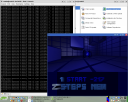I am always a bit reluctant to upgrade instead of just install because it is a much less tested use case and there is always the conflict between your own preferences and new defaults: who has precedence? But an OS should be meant to be upgradable, right? I know, most people are not confronted with the issue since Windows isn’t exactly what I would call an good example of an upgradable OS 😉 Linux users are much more confronted with the upgrade issue since most distro’s put out at least one release a year. I always give the upgrade a shot, but most of the time I also do a new install just to know how the new release was meant to be conceived. 😉
So here is my upgrade story for my laptop: it’s a Dell D830 with Nvidia Quadro NVS 140 and Intel(R) PRO/Wireless 3945ABG.
The upgrade procedure itself went smooth although I never really know if I have to enable more repositories or not when asked. The upgrade will by default only take the default suse repo’s into account. So I left it that way, but it could explain a few issues I ran into later..
Anyway, after the upgrade reboot, I don’t get a graphical login screen.. I run sax2, and this fixes the issue, but nvidia driver is not used. So I add the nvidia repo from the community repository list. I see there is now a new driver “G02” instead of the “G01” I used to use. So I mark this package for installation, but some dependencies fail.. I don’t know the exact list anymore, but one of them was related to the kernel, which surprised me as I just upgraded (but I did have the jengelh realtime kernel installed before I upgraded).
Something was odd with the package management.. and I also got an error that updates could not be found because no backend was configured. what the..? So next thing to do, was configure the online update. When I tried that, it wouldn’t work because “SSL negotation failed”. This definitely smelled like a bug, so I filed one and it has already been confirmed by a suse employee by now.
So I added the update repo manually (although I had read about the new smolt integration and would’ve loved to register my system) and configured the new updater applet (kupdateapplet, which supports packagekit) to use the zypper backend which I first had to install manually (kde4-kupdateapplet-zypp). Finally some updates were found, but the new tool failed to install the patches (have to file a bug next time patches are issued) and asked me if I wanted to use yast instead. Funny how they anticipated problems there. 🙂 Using yast, there was no problem of course. The smolt update even triggered a proper nvidia install without dependency problems.
Having updated, after I relogged on, the nvidia driver was effective and remembered its configuration from before the upgrade. Since the version was now called G02, I had high hopes that this would incorporate all the fixes NVidia addressed in their beta drivers to get rid of the KDE4 desktop effects performance problems, but alas, it seems this is still beta. I might want to install the beta driver after all, I’m tired of the bad performance. 😉 My ATI radeon 9800 PRO in my desktop performs better! Although I have to admit, even the stable nvidia drivers seem to have received a few improvements the last few months.
That’s it for now!
